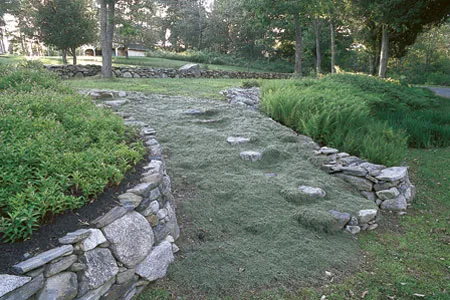Softening the edges of garden paths and patios with low-growing plants can transform your outdoor space. These resilient perennials can withstand foot traffic and blend hardscape elements seamlessly into their surroundings. From creeping thymes to hardy groundcovers, the right plant can turn bare, worn areas into vibrant, green spaces. This guide will help you choose the perfect plants to edge your paths and patios, creating an inviting landscape.
Understanding the Role of Path and Patio Plants
Path and patio plants serve many purposes in landscaping. They soften hard edges, prevent soil erosion, and add visual interest to otherwise plain areas. These plants withstand different degrees of foot traffic, from light to heavy, making them ideal for areas where grass struggles to grow. Some varieties even act as natural weed suppressants.
Choosing the Right Plants for Heavy Foot Traffic
When selecting plants for high-traffic areas, durability is key. These plants need to withstand frequent stepping and maintain their appearance. Here are some top choices for both sunny and shaded areas.
Full Sun Options
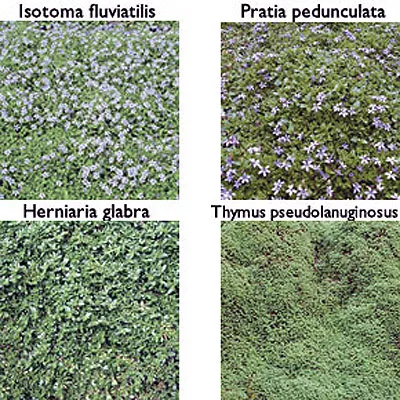
For areas that receive abundant sunlight, choose one of these plants:
- Blue Star Creeper (Isotoma fluviatilis): This rapid-spreading perennial grows blue flowers and works well around roses, decks, and in rock gardens.
- Creeping Thyme (Thymus praecox ‘Elfin’): This drought-tolerant plant has tightly matted gray-green foliage and pink flowers and is great between flagstones.
- Green Carpet or Rupturewort (Herniaria glabra): this evergreen groundcover turns red in the winter and is perfect to place along your walkways.
- Woolly Thyme (Thymus pseudolanguinosus): This groundcover has fuzzy gray-green leaves and pink blooms, which are best for flagstones and pathways.
Partial to Full Shade Choices
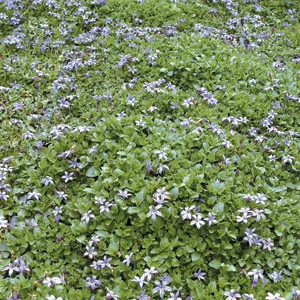
For areas with less direct sunlight, try these shade-tolerant options:
- Miniature Brass Buttons (Leptinella gruveri): This carpet of tiny serrated leaves can even withstand car traffic, making it best for driveways and heavily used paths.
- Irish Moss (Sagina subulata): While not actually moss, this mosslike groundcover with white flowers is great between stones and in rock gardens.
- Creeping Jenny or Moneywort (Lysimachia nummularia): This plant grows a fast-spreading mat of bright green leaves with yellow flowers, perfect for shadier pathways.
- Miniature Rush (Eleocharis radicans): These low-growing, tiny grasslike blades thrive in wet conditions, making it a good choice around ponds or water features.
Best Plants for Moderate to Light Foot Traffic
Areas with less frequent foot traffic allow for a wider range of plant options. These plants add more visual interest and variety to your landscape.
Sun-Loving Varieties
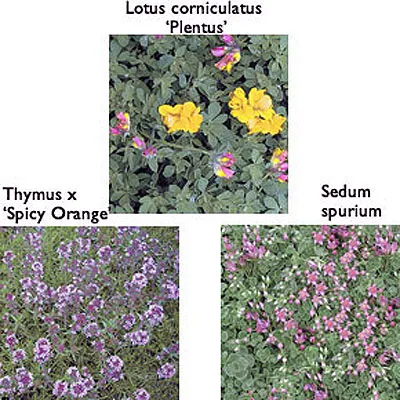
For sunny spots with moderate traffic, choose a few of these options:
- Double Bird’s Foot Trefoil (Lotus corniculatus ‘Plenus’): A versatile, fast-growing plant with dark green leaves and yellow blooms.
- Miniature Daisy (Bellium minutum): These diminutive spreading daisies on wiry stems are great between paving stones or in border areas.
- Pink Pussy Toes (Antennaria dioica ‘Rubra’): These grow into a mat of silver-gray leaves with fuzzy pink blooms, making them ideal for rock gardens and paths.
- Stonecrop (Sedum spurium): This compact creeping succulent with deep purple flowers is common for rock gardens and path edges.
Shade-Tolerant Species
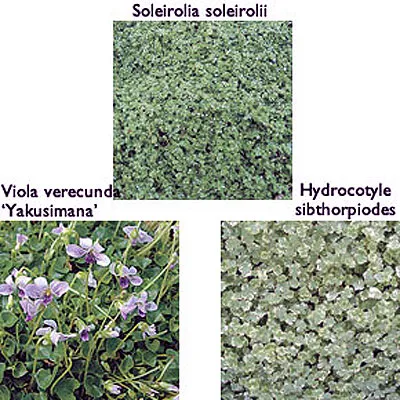
For shadier areas with light traffic, try these plants:
- Baby Tears (Soleirolia soleirolii): A mat of dense, green-and-white leaves with pink flowers, perfect for shaded path edges.
- Creeping Speedwell (Veronica repens): This creeper with white flowers works well between pavers or in woodland settings.
- Miniature Viola (Viola verecunda ‘Yakusimana’): Mounds of tight green leaves with purple-and-white blooms can add color to shaded paths.
- Pixie Carpet (Hypsela reniformis): With tight green leaves and lavender-and-white blooms, this plant thrives in cool, moist conditions, especially around fountains or between stones.
Key Factors When Selecting Border Plants for Patio Edges
Choosing the right plants for your paths and patio edges involves more than just the design you’re looking for. Account for the following factors to make sure your plants thrive and grow in their new space.
Soil Type and Drainage
Most creeping perennials prefer well-drained soil. Before planting, assess your soil type and improve drainage if necessary. Some plants, like Miniature Rush, prefer wet conditions, while others, like Stonecrop, do better in drier soils. Match your plant choices to your soil conditions for the best results.
Climate and Hardiness Zones
Select plants that are suitable for your specific climate and hardiness zone. While many perennials are adaptable, some may struggle in extreme temperatures. Research each plant’s temperature tolerance to make sure it can withstand your local weather conditions year-round.
Growth Rate and Spread
Factor in how quickly your chosen plants will spread and how much space they need. Some varieties, like Creeping Jenny, spread rapidly and require regular trimming to keep them in check. Other, like Miniature Thyme, have a slower growth rate, making them best for smaller spaces or areas where you want to maintain a specific design.
Designing with Path and Patio Edge Plants
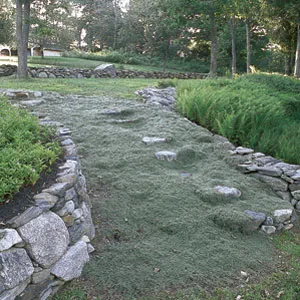
Incorporating plants into your landscaping can elevate the look of your outdoor space. Here are some tips for creating a cohesive and unique design.
Creating Visual Interest
Mix and match different plant varieties to create texture and color contrasts. Incorporate plants with different bloom times for year-round interest. Use taller plants sparingly to create focal points in your landscape without obstructing the pathway.
Complementing Existing Landscaping
Choose plants that complement your existing design. Choose color schemes that coordinate with your home and garden for a cohesive look across your exterior. Use spread plants to soften edges and create a more seamless transition between hardscape and landscape.
Maintenance Tips for Healthy Path and Patio Plants
Proper care of your path and patio plants will keep them healthy and attractive. Follow the maintenance guidelines below to keep your plants thriving.
Watering and Fertilizing
Most creeping perennials prefer consistent moisture but can tolerate short, dry spells once they’ve rooted. Water deeply but less frequently to encourage root growth. Apply a 20-20-20 liquid fertilizer during the growing season for healthy growth and blooming.
Pruning and Trimming
Regular pruning helps maintain the shape and size of your plants. Trim back fast-growing species to prevent them from overtaking your paths. Remove dead or yellowing leaves to keep your plants looking tidy and to prevent disease. Some plants also benefit from a light trim after flowering to promote bushier growth.
Innovative Ways To Incorporate Plants in Hardscaping
If you want more creative options to implement plants into your garden, we have a few unique and beautiful ideas to try out.
Between Pavers and Flagstones
Plant low-growing varieties between pavers or flagstones to create a lush, green carpet. This helps prevent weeds from taking hold and keeps the space attractive. For an even more unique look, use contrasting plants in alternating spaces.
Along Driveways and Walkways
Edge driveways and walkways with tough, spreading plants. These plants can withstand occasional car tires and frequent foot traffic while adding a soft, green border to hard surfaces. For a pop of color, add flowering varieties throughout your spreading plants.
Solving Common Landscaping Problems with Border Plants
Border plants do more than just look visually appealing. They can also help solve common landscaping issues including erosion, temperature, and weed suppression.
Erosion Control
Plants with dense root systems can help prevent soil erosion on slopes and banks. Plants like Creeping Thyme and Rupturewort create a living mat that holds soil in place, even during heavy rain.
Weed Suppression
Dense, low-growing plants like Green Carpet and Woolly Thyme act as natural weed suppressants. They shade the soil and prevent weed seeds from germinating, reducing the need for chemical herbicides and manual weeding.
Noise Reduction and Temperature Regulation
Low-growing, dense plants can help with noise reduction by absorbing sound waves, making your garden quieter and more peaceful. Around patios, these plants can moderate temperatures by providing a cooling effect, making your outdoor seating areas more comfortable.
Attracting Pollinators
To create a pollinator-friendly garden, plant varieties that attract bees, butterflies, and other beneficial insects. Creeping Thyme, especially when in bloom, is known for attracting pollinators. Integrating these plants into path edges can make your garden more eco-friendly by supporting local biodiversity.
